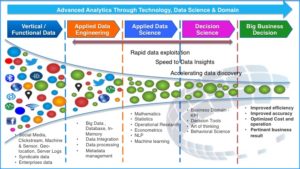Based on National Health Morbidity Survey 2017 (NHMS 2017) by the Health Ministry’s Institute for Public Health (IPH) 2017, high school students in Malaysia are at risk for mental health problems. The results from the studies show that 18.3% high schoolers are suffering from depression, 39.7% have anxiety and 9.6% dealing with stress.
This is a master project by Aizat Nuruddin. He is predicting Mental Illness among High School Students in Malaysia. Using Data from National Health and Morbidity Survey (NHMS 2012). Hopefully the symptoms and factors identified can help alarming the situation.
https://youtu.be/lnfeuFanmmo
Category Archives: Predictive Analytics
Analysis, analytics, trend and forecasting
Analysis Definition:
1. A systematic examination and evaluation of data or information, by breaking it into its component parts to uncover their interrelationships. Opposite of synthesis.
2. An examination of data and facts to uncover and understand cause-effect relationships, thus providing basis for problem solving and decision making.
Analytical Definition:
The field of data analysis. Analytics often involves studying past historical data to research potential trends, to analyze the effects of certain decisions or events, or to evaluate the performance of a given tool or scenario. The goal of analytics is to improve the business by gaining knowledge which can be used to make improvements or changes.
Then from the analytical, come forecasting – the prediction from the past and present trend of analysis.
Forecast Definition:
A planning tool that helps management in its attempts to cope with the uncertainty of the future, relying mainly on data from the past and present and analysis of trends.
Forecasting starts with certain assumptions based on the management’s experience, knowledge, and judgment. These estimates are projected into the coming months or years using one or more techniques such as Box-Jenkins models, Delphi method, exponential smoothing, moving averages, regression analysis, and trend projection. Since any error in the assumptions will result in a similar or magnified error in forecasting, the technique of sensitivity analysis is used which assigns a range of values to the uncertain factors (variables).
Trend Analysis Definition
Method of time series data (information in sequence over time) analysis involving comparison of the same item (such as monthly sales revenue figures) over a significantly long period to (1) detect general patter of a relationship between associated factors or variables, and (2) project the future direction of this pattern.
As a conclusion, by referring to my previous post about https://people.utm.my/suraya/2017/09/14/predictive-analytics-vs-business-intelligence/ , then analysis is more on BI and analytics and forecasting is more on Predictive Analytics.

Predictive Analytics vs Business Intelligence
According to tibco (2017), flat dashboards (err… most probably, they are referring to BI) are killing analytics. When it comes to data visualization technologies, most vendors offer similar insights, along with graphing and storytelling functionality. What you most often see are screens with two or three panels that have a nice looking graph or two. If you click on the graph or adjust the controls, the visualization may change. It’s not bad. You can explore simple data sets, usually those stored in a spreadsheet table. You get fast results. You might even apply a statistical function or two. These dashboards are fundamentally fat. If you had magic virtual reality glasses and could pull the dashboard of the screen and look at the way it was made, you might see an inch or two of data and analytics behind each panel. If you want to change the data used or adjust the analytic, you go back to the spreadsheet or to the statistics package that calculated the analytic.
Flat dashboards provide a limited amount of insight. Usually, when fat dashboard technology is used in a company, it becomes a form of reporting, offering static information. The result is a proliferation of low-value visualizations that analyze small sets of data for individuals or groups. In a typical company, there could be hundreds or thousands of these low-value reports, which leads to a management and maintenance nightmare. Furthermore, because reports are uncoordinated, ad-hoc, and based on tiny slices of whatever-data-is-on-hand, they often lack a level of correctness and completeness, which canlead to incorrect conclusions and business mayhem. The old adage “garbage in, garbage out” too often applies to fat dashboards.
http://www.olspsanalytics.com/predictive-analytics-vs-business-intelligence/

